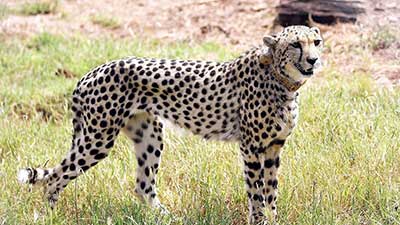Date: 12/05/2023
Relevance: GS-3: Conservation, Environmental Pollution, and Degradation, Environmental Impact Assessment.
Key Phrases: India’s Project Cheetah, renal infection, Kuno National Park, International Union for Conservation of Nature, incentivize local communities, poaching, cheetah reintroduction, Wildlife Breeding Programs, genetic diversity.
Why in News?
- India’s Project Cheetah aims to establish a sustainable population of about 35 cheetahs in the next decade by bringing in a few every year from Africa.
- It is almost three months since South Africa sent a batch of 12 cheetahs to India and two have already died.
- Taken along with the death of one of the eight cheetahs from Namibia — it had a pre-existing renal infection — and it emerges that about 15% of the animals have not made it past the first phase of India’s ambitious Project Cheetah.
- It is implicit that there will be many deaths among the animals if one factor in both the natural lifespan of the cat as well as the challenges of adapting to Indian conditions.
Cheetah
- ‘Cheetah’ (Acinonyx Jubatus Venaticus) originates from Sanskrit and means ‘the spotted one’.
- The last cheetah died in the Koriya district of present-day Chhattisgarh in 1947 and the species was declared extinct in 1952.
- Asiatic Cheetah is considered Critically Endangered under the International Union for Conservation of Nature's (IUCN) red list of threatened Species.
- African Cheetah is considered vulnerable under the IUCN Red list.
Kuno National Park
- Kuno National Park is a national park and Wildlife Sanctuary in Madhya Pradesh, India.
- It derives its name from the Kuno River. It was established in 1981 as a wildlife sanctuary.
- In 2018, it was given the status of a national park.
- It is part of the Khathiar-Gir dry deciduous forests ecoregion.
Background of India’s Project Cheetah:
- India’s Project Cheetah is a translocation program aimed at reintroducing cheetahs, a species that went extinct in India in the 1950s, back into the country.
- The project has been in the making for over a decade, with the government working to create a suitable habitat for the big cats.
- The Kuno National Park in Madhya Pradesh was selected as the site for the project, and the government negotiated with Namibia and South Africa to bring in a few cheetahs every year.
- The project has received widespread publicity, with the Prime Minister himself endorsing the initiative.
Challenges Faced by the Project:
- The recent deaths of three cheetahs have raised questions about the conservation approach adopted by experts.
- Critics argue that the Kuno National Park is inadequate to host 20 cheetahs and that some of the animals should be relocated to other sanctuaries.
- There are also concerns that the cheetahs lived in captivity for too long before being translocated, which could have made them more vulnerable to stress and other health issues.
Response of Project Managers
- Project Cheetah managers have defended their conservation approach, citing investments made in creating an adequate landscape stocked with prey, consulting with experts in Namibia and South Africa with experience in managing cheetahs, and cultural traditions that minimize poaching and incentivize local communities to be protective of wildcats.
- They argue that the cheetah translocation program is an experiment and that every death and every birth should not be seen as markers of failure or success.
- However, they also acknowledge the need for clearly defined criteria with timelines to decide if a course correction is warranted.
Measuring the Success of Wildlife Breeding Programs:
- The success of wildlife breeding programs cannot be measured over short intervals. It takes sustained efforts over decades to see significant changes in population numbers.
- The increase in the lion population in Gir, Gujarat, as well as tiger numbers have been the result of sustained efforts over decades, that have also seen the wildcat count dip to precipitous levels.
- However, the success of breeding programs is also dependent on several factors, including adequate habitat, genetic diversity, and protection from poaching and other threats.
- Conservation efforts must also adapt to changing conditions and incorporate new scientific knowledge.
Conclusion:
- India’s Project Cheetah is a high-profile conservation initiative aimed at reintroducing a species that went extinct in the country decades ago.
- The recent deaths of three cheetahs have raised concerns about the effectiveness of the conservation approach adopted by experts.
- While it is still too early to judge the success of the program, it is essential that project managers adhere to clearly defined criteria with timelines to decide if a course correction is needed.
- The success of wildlife breeding programs depends on several factors, and conservation efforts must be adaptable and based on sound scientific principles.
Source: The Hindu
Mains Question:
Q. Critically evaluate India's Cheetah reintroduction program, highlighting the challenges and potential drawbacks associated with translocating cheetahs from Africa to India.






















